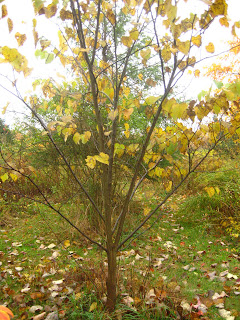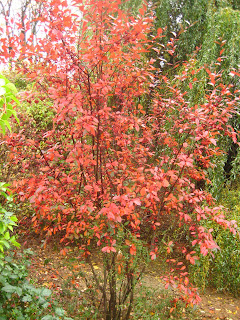Planting for wildlife, Native Plants as a Food Source
Attracting more wildlife to your yard is as simple as providing their basic needs: shelter, food, water, and nesting sites. In the wild you'll find sources for these survival needs from the tallest trees down to the forest floor. It is important to plant diciduous and evergreen trees as well as the many perennial and annual herbaceous plants.
We mustn't forget the importance of what makes up the hedgerows. These areas are much more than unkept wild areas of stickers, vines and weeds.
Shrubs and bushes are what is called the understory trees in a mixed forest. They not only provide additional food and cover for wildlife but they help nourish and cool the forest floor for the health of the larger trees. The larger trees give them the necessary dappled protection they need from the full sun.
Fall is the perfect time to plant since the plants are not in an active growth stage therefore require less water. Getting them in the ground before a hard frost gives them enough time to get established before winter and then in the Spring the roots are ready to uptake water and nutrients for the demands of new growth.
Below are a glimpse of a few ideal berry producing shrubs for feeding birds and many forms of wildlife when other food sources start to dwindle. Here you can get an idea of not only their autumn color display but the general shape of the tree. To see what some of these shrubs look like in the spring check out this post, The Marvels of May.
 |
| Eastern Redbud |
 |
| Washington Hawthorn |
 |
| Pyracantha Firethorn |
 |
| Barberry |
| Barberry bushes come in several varieties and serve several functions. They are very decorative throughout the seasons, offering not only a food source to birds and small animals but also safety within its thorny branches. I have yet to see a cat go after anything once it is safely within a barberry bush. However, Japanese Barberry has it's drawbacks. It is now considered an invasive plant and tends to harbor ticks that can carry Lyme disease. |
 |
| Flowering Dogwood |
The always popular Flowering Dogwood (Cornus florida) thrives in zones 5-8
It is a short-trunked tree growing to about 15 - 25 ft. tall. A beautiful display of white flowers in the spring turn to shiny red clusters of berrylike fruits. As seen above the foliage turns a brilliant red in the Fall.
 |
| Pagoda Dogwood |
 |
| American cranberrybush Viburnum |
If this shrub likes its location it can grow 12-15 ft tall with an 8-10 ft. spread. The month of May brings clusters of small white flowers with become bright red fruits by late summer. These fruits are edible though very sour and can remain on the bush all winter. Usually around March the cedar waxwings, traveling in groups, visit just long enough to strip the bushes clean. It is so neat to witness their short stay and know there was a food source available when food sources still appear so bleak. The maple like leaves turn a beautiful shade of red before they drop and leave behind the decorative berry display/
 |
| Chokeberry |
 Very pretty and easy to fit in a smaller landscape, Chokeberry (Aronia melanocarpa) zones 3-9. Smaller than the Common Chokecherry, this shrub only gets about 6 feet tall. By fall it is loaded in dark berries. Red in color it is just such an attractive little tree. |
 |
| Winterberry Holly |
This shrub may reach 15 ft if grown in wetlands though it seems to do just fine in a garden setting. Once the leaves turn yellow and fall the bare, dark gray branches look so pretty with its abundant red berries.
 |
| Nannyberry |
The Nannyberry, another type of Viburnum, grows to a small tree size of about 30 ft. and doesn't seem to spread in width as does the American cranberrybush. Its foliage turns more of a purple red color in the fall and its berries are small bluish-black that hang onto the bush late into the winter. This shrub also like moist soil but as long as is in full sun to partial shade and good soil it does fine.

The flowering crabapple (Malus) is a spring-blooming tree in the Rosaceae family. While crabapple trees are closely related to apple trees, they typically bear smaller fruit and have slightly different blooms, leaves and growth habits.The tree pictured has white, pink tinged flowers in the spring and small red fruit in the autumn. An attractive little tree, these trees have an average height of about 10 - 15 feet.
 Filbert trees (also called Hazelnut
trees) are ideal nut trees for either your own harvest or left for the wildlife. If left alone in a naturalized setting, they become large shrubs with many trunks. But with pruning they can be shaped into a single small tree. Leaves of the filbert or hazelnut tree are a
valued food source for wildlife, including several species of butterfly.
Filbert trees (also called Hazelnut
trees) are ideal nut trees for either your own harvest or left for the wildlife. If left alone in a naturalized setting, they become large shrubs with many trunks. But with pruning they can be shaped into a single small tree. Leaves of the filbert or hazelnut tree are a
valued food source for wildlife, including several species of butterfly.
 Once mature, the clusters of nuts will drop to the ground and can either be left for the wildlife or gathered and dried for human consumption.
Once mature, the clusters of nuts will drop to the ground and can either be left for the wildlife or gathered and dried for human consumption.When it comes to planting trees and shrubs we have to keep in mind that we're planting for the future and we must have patience. It is easy to see these plants in catalogs and visualize that same beautiful addition in your landscaping. It takes a few years for trees to really get established, take form and become a specimen plant.
However, once they are planted, the hardest work is done. You may have to protect them from deer damage while young but being native to North America they should flourish.
The exceptions are: Barberry is a native of Europe and the Firethorn is a native of China.
Should you have trouble finding these natives at your local nurseries check with the Cooperative Extension Office for your county. They are a great source for all types of gardening, landscaping, agricultural and livestock questions but can also tell you where to find the native plant sales in your area. They are usually in the spring and/or the fall season.
 | ||
| Cedar Waxwings |
Insect and fruit eating Cedar Waxwings made a brief appearance in March when they passed through searching for those last berries still clinging to our American Cranberry Bushes. (However in this photo they are perched in a Willow tree). Native trees and shrubs are very important food sources for insect eating birds arriving before it is warm enough for the bugs to be out and about.


No comments:
Post a Comment